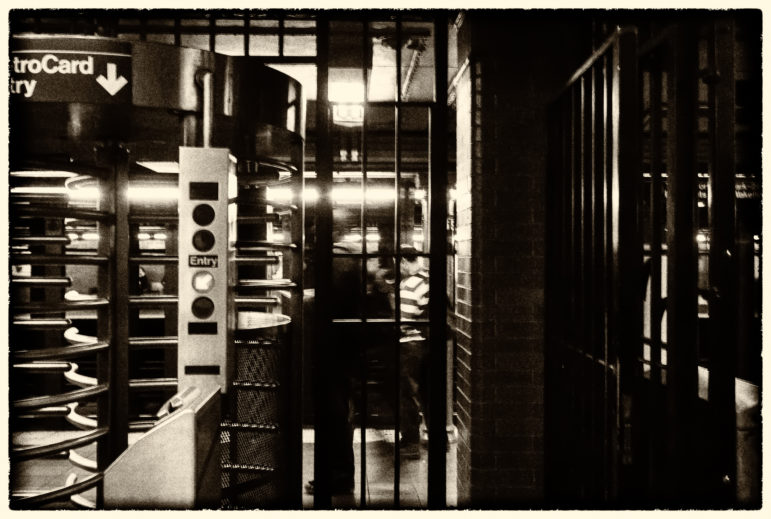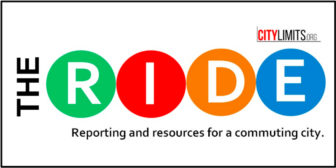
New York City Transit Authority (NYCTA) President Andy Byford said earlier this month that a big part of the system’s budget woes are the direct result of individuals who don’t pay their fare. He went onto say fare revenue—which makes up just under half of the MTA operating budget—is expected to take a $215 million hit from fare dodgers by the end of 2018.
Byford cast much of the blame for this phenomenon on a June 2017 decision by Manhattan District Attorney Cyrus Vance whereby police would instructed to no longer prosecute the majority of fare evaders. “It’s quite striking that that change in policy has led to a remarkably coincidental rise in fare evasion,” Byford reportedly said.
NYCTA is even considering sending “eagle teams”of uniformed MTA employees into the system to deter, shame and catch evaders, according to local news reports.
Although the lost fare revenue numbers are staggering, Byford’s perspective on the current turnstile jumper trend reeks of condescension and a clueless disregard for the city’s glaring socio-economic inequity. Public transit has grown increasingly unaffordable for many low-income New Yorkers and it will only get worse with each fare hike.
A 2016 survey from the Community Service Society found that one out of four low-income, working-age city residents say that they often can’t afford to ride the bus or subway, and typically spend more than 10 percent of their family budget on transit costs. In fact, 58 percent of poor New Yorkers rely on the subway and buses as a means of transportation—more so than any other income group.
In a truly just and fair city, public transit would be an affordable lifeline to economic opportunity. The subway and bus system would support upward mobility and the best way to bring that vision to fruition, would be to do away with subway and bus fares altogether.
That’s right, make the subway free for everyone.
No doubt, naysayers would howl with laughter at such a ridiculous sounding notion—despite it’s abject practicality. It’s right up there with other dreamy ideas, such as repurposing a full lane of the Brooklyn Bridge into a dedicated two-way bike path.
While a fare free subway is almost certainly a distant dream, putting a cap on fare growth could be a real possibility if the city and state’s political leaders made it a priority. The key would be nailing down sustainable funding sources that would not only keep transit running, but also enable much needed investment in the system’s crumbling infrastructure and crippling technology. But laying MTA’s budget burdens on the New Yorkers who rely on the system each day for their livelihood is unacceptable. It is as regressive as it is unfair.
Why is Byford—the seasoned transit system vet who was cast as the much-needed savior for the beleaguered NYCTA—not using his position to aggressively advocate for bold more equitable and dedicated funding mechanisms instead of lassoing up fare beaters?
Byford’s comments border on the absurd, especially when they come on the heels of news that MTA is planning to impose a whopping four percent fare hike next year.
The agency is floating two options—One would keep base MetroCard fares at $2.75 and eliminate the purchasing bonus. Thirty-day MetroCards would increase from $121 to $127 and seven-day MetroCards would rise from $32 to $33.
The second would increase base MetroCard fares to $3 and increase purchasing bonuses from 5 percent with a $5.50 purchase to a 10 percent bonus with a $6 purchase. Monthly MetroCards would see a slightly smaller increase to $126.25 while weekly ones would still increase to $33.
Thanks to the hard fought efforts of transit advocacy groups such as Riders Alliance, NYPIRG and Community Service Society, the city agreed in June to fund half-price Metrocards for New Yorkers living at or below the federal poverty level.
But the Fair Fares program, which should begin in January, will only offer 7-day or 30-day passes at half price. Single ride fares will remain the same, $3. Anyone who’s lived check-to-check has experienced a day when they struggled to scrape up subway fare to get to work on the day before payday.
This impending fare hike comes as service has grown more erratic at best. I feel fortunate to be physically able to use my bicycle as a primary mode of transportation on most work days. When I commute by train, unpredictable delays, overcrowding and a general pall of frustration can set a less than stellar tone for the rest of my day. Over the years, I’ve written about the subway, and came to better understand the dire financial challenges the system faces. But asking frustrated riders to take on more of the system’s burdens adds collective insult to injury.
There is no way to gloss over the fact that bus or subway fares have skyrocketed in just the past few years.
In fact, fares increased by 53 percent since 2007, almost three times faster than the inflation rate for the metropolitan region, according to an October report from the State Comptroller’s office. Aside from maddening MTA budget mismanagement and years of misplaced spending priorities, this latest fare spike shows us that state and city political leaders have not had the guts to use their muscle to advocate for fair funding schemes that could at least begin to shore up MTA’s shaky finances.
New Yorkers are left to conclude that both the mayor and governor are complicit in Byford’s seemingly misguided punitiveness. Because if either of them were the righteous apostles of progressivism they so often claim to be, affordable transit for all New Yorkers would be an urgent priority. And so too would be new dedicated funding sources for the system’s capital projects. There are ideas out there, such as value captures—the taxing building owners whose properties increase in value as a result of being near transit—and then mayor’s millionaire tax idea.
But it’s congestion pricing—charging cars just over $11 to drive into Manhattan’s busy business districts south of 60th street—that could generate between $810 million and $1.1 billion annually according to the governor’s Fix NYC report last January, that’s the most solid option and now stands its best chance of becoming reality now that Democrats will control Albany.
Congestion pricing revenue would wipe away the $215 million lost to fare beaters—and boost the system’s coffers to a somewhat healthier level.
As things stand, millions of New Yorkers with limited incomes will continue to experience days where they are forced to choose between food and going to a job interview, class or work. Meanwhile, the city and state’s top politicos offer up billion-dollar tax incentives to incoming corporations and commercial real-estate projects, well moneyed operations which directly benefit from the ailing public transit system.
If ever there were a time to contemplate the values New York City embodies and the priorities for its future, our subway system is the prime place to have that collective conversation.
Cody Lyon is a New York City-based journalist.










6 thoughts on “CityViews: The New York City Subway Should Be Free”
-do the math.
-track the budget.
-ask questions from uninterested parties, then smart logical people, purported experts next, the government/authority last.
-create meaningful charts and information to ease understanding and analysis.
-publish meaningful analysis to instigate action.
-all else is hand waving nonsense. to label an article that subways should be free and to not do the math and to backtrack from that premise before doing the math is lazy.
It’s an op-ed, and clearly labeled so.
The author is shortsted and ridiculously so. Free mass transit will inevitably get paid by higher taxes and congestion pricing by increased cost of goods and services, which will, as always is the case in a city with a government that responds to the affluent and soon-to-be affluent exclusively, by the poor and middle class, those demographics that have been, over two administrations, subject to legislation designed to drive them out of New York. The author’s proposals would further that effort. It’s funny how the loudest cries for subway reform emerge from the Ubbering class, those whose abandonment of mass transit has help accelerate its decline.
Free transit in NYC has a lot of appeal, but financially it would be a heavy lift. As two commenters already said, any argument like this needs to lay out how to pay for it. Cody Lyon tap dances around it.
Have the many billionaires who have made their money because of labor force who ride the subways pay for the subways. The whole state that benefits from NYC should pay for the subways. They get the taxes from NYC that is the financial engine for the whole state.
Pingback: The New York City Subway Should Be Free – Cody Lyon